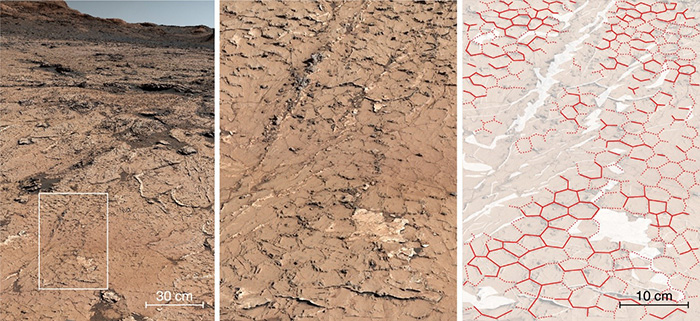Publication of the LGL-TPE in the journal Nature, on August 9, 2023. Press release of CNRS on August 9, 2023.
- Scientists have discovered fossil evidence of a cyclical climate on Mars, with wet and dry seasons like those on Earth.
- This environment, in which simple organic molecules have already been discovered, may have provided ideal conditions for the formation of complex organic compounds.
- This work opens up new prospects for research into the processes underlying the origin of life, of which no vestiges remain on Earth.
Using data from NASA's Curiosity rover, scientists at the CNRS, Université Toulouse III – Paul Sabatier and Claude Bernard Lyon 1 University (LGL-TPE), with the participation of CNES, have discovered patterns on Mars that provide evidence of a cyclical climate similar to that of Earth's. This major discovery opens up new prospects for research into the origin of life. The results of the study are published on 9 August 2023 in the journal Nature.
The surface of Mars, unlike the Earth's, is not constantly renewed by plate tectonics. This has resulted in the preservation of huge areas of terrain remarkable for their abundance in fossil rivers and lakes dating back billions of years. Since 2012, NASA's Curiosity, the first rover to ever explore such ancient remains, had already detected the presence of simple organic molecules which can be formed by geological as well as biological processes.
However, the emergence of primitive life forms, as hypothesised by scientists, initially requires environmental conditions favourable to the spontaneous organisation of these molecules into complex organic compounds. Such conditions are precisely what have recently been discovered by a research team from the Institut de Recherche en Astrophysique et Planétologie (CNRS/Université de Toulouse III - Paul Sabatier/CNES) and the Laboratoire de Géologie: Terre, Planètes, Environnement (CNRS/ENS de Lyon/Université Claude Bernard Lyon 1), together with their US and Canadian colleagues.
Using the Mastcam(1) and the ChemCam(2) instruments on Curiosity, they have discovered deposits of salts forming a hexagonal pattern in sedimentary layers dating from 3.8 to 3.6 billion years ago. Similar to the hexagons observed in terrestrial basins that dry out seasonally, they are the first fossil evidence of a sustained, cyclical, regular Martian climate with dry and wet seasons. By letting molecules repeatedly interact at different concentrations, independent laboratory experiments have shown that this kind of environment provides the ideal conditions for the formation of complex precursor and constituent compounds of life, such as RNA.
These new observations should enable scientists to take a fresh look at the large-scale images obtained from orbit, which have already identified numerous terrains with a similar composition. They now know where to look for traces of the natural processes that gave rise to life, of which no vestiges remain on Earth.

© NASA/JPL-Caltech/MSSS/IRAP/Rapin et al./Nature
Notes
- https://mars.nasa.gov/msl/spacecraft/instruments/mastcam/
- ChemCam was built by a French-US consortium under the responsibility of the Institut de Recherche en Astrophysique et Planétologie (CNRS/Université de Toulouse III - Paul Sabatier/CNES) and the Los Alamos National Lab (United States). In France, the design of the instrument was funded by the French space agency CNES, the CNRS, the French Alternative Energies and Atomic Energy Commission CEA, and a number of universities. Mars Science Laboratory is a NASA mission run by the Jet Propulsion Laboratory (USA), which designed and operates the Curiosity rover.
Reference
Sustained wet-dry cycling on early Mars. W. Rapin, G. Dromart, B.C. Clark, J. Schieber, E.S. Kite, L.C. Kah, L.M. Thompson, O.Gasnault, J. Lasue, P-Y. Meslin, P.J. Gasda, N.L. Lanza. Nature, 9 août 2023
DOI : 10.1038/s41586-023-06220-3





